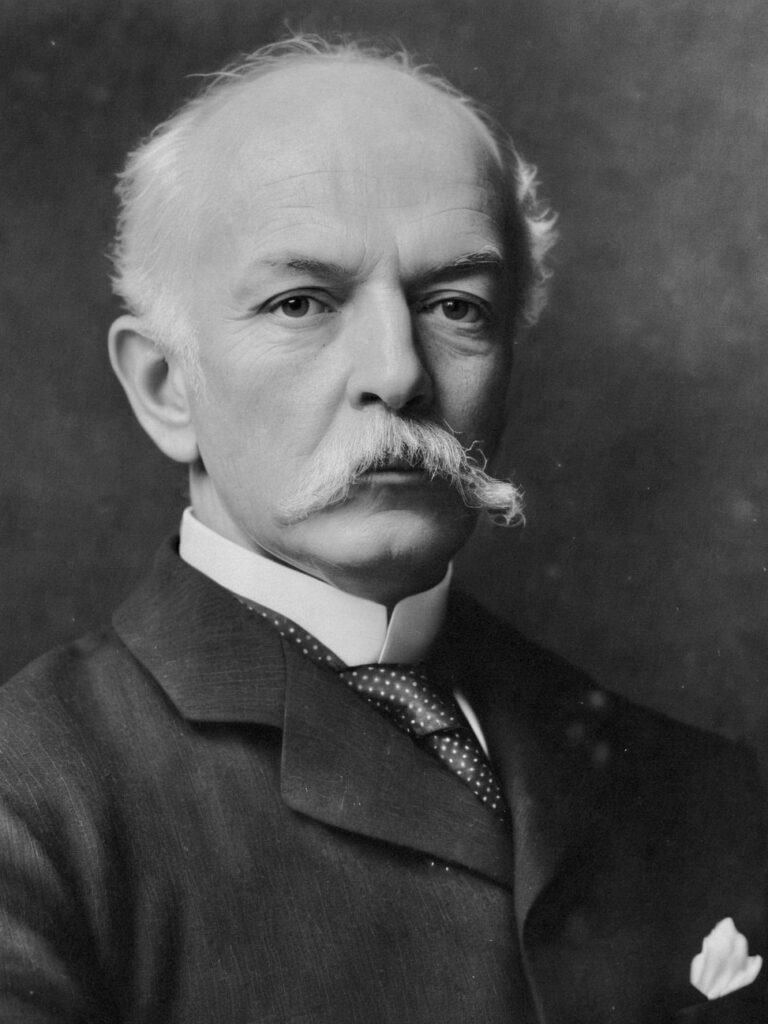Charles McBurney

Charles Heber McBurney (1845-1913) was an American general surgeon.
McBurney was a pioneering American surgeon whose name is eponymously associated with “McBurney’s point” and the “McBurney incision,” both fundamental in the early diagnosis and surgical treatment of acute appendicitis. Educated at Harvard and the College of Physicians and Surgeons in New York, McBurney helped transform abdominal surgery at a time when operative intervention for intra-abdominal pathology was highly controversial.
A meticulous clinician and advocate for early laparotomy, McBurney was instrumental in shifting the paradigm away from conservative management toward surgical resolution of appendicitis. His anatomical precision, innovative operating techniques, and surgical leadership contributed significantly to the development of safe abdominal surgery in the late 19th century.
McBurney published important work on the treatment of pyloric stenosis; management of shoulder dislocation with fracture and a transduodenal approach for stone extraction from the lower end of the bile duct. An advocate of the use of rubber gloves during surgery to improve aseptic technique.
Biography
- Born on February 17, 1845, in Roxbury, Massachusetts
- 1862-1866 Harvard University (BA, MA)
- 1870 – MD, College of Physicians and Surgeons, Columbia University in New York
- 1870–1872 – Postgraduate studies in Vienna, Paris, and London
- 1872 – Returned to New York; began private surgical practice
- 1873 – Appointed Demonstrator in Anatomy at the College of Physicians and Surgeons
- 1880 – Appointed Assistant Surgeon, Bellevue Hospital
- 1888 – Appointed Surgeon-in-Chief, Roosevelt Hospital, New York. Mount Sinai staff surgeon; assumed responsibility for the design and planning of a new operating pavilion, the William J. Syms Operating Theatre.
- 1889 – Professor of Surgery at Columbia University; described diagnostic “McBurney’s Point” for appendicitis
- 1890s – Pioneered operations on the common bile duct; advocated duodenal approach
- 1891 – Advocated early operative treatment for appendicitis in landmark paper
- 1894 – Published surgical technique of the “McBurney Incision”
- 1900s – Promoted use of rubber gloves in surgery
- 1901 – Professor of Clinical Surgery at Columbia University
- 1901 – Attended President William McKinley after being shot at close range
- 1905 – Retired due to declining health
- 1907 – Professor Emeritus of Surgery
- Died on November 7, 1913, in Brookline Massachusetts, aged 68 from heart disease.
- Posthumous – Recognized by surgical societies worldwide; Syms Pavilion designated a historical landmark
Medical Eponyms
McBurney’s point (1889)
First described in 1889, McBurney’s point is the location of maximal tenderness in early acute appendicitis. McBurney defined this spot as 1½ to 2 inches from the right anterior superior iliac spine along a line drawn to the umbilicus. This clinical sign rapidly became a cornerstone in the diagnosis of appendicitis, often prompting timely surgical intervention. Its enduring utility in physical examination reflects McBurney’s impact on clinical reasoning and anatomical localization in acute care.
First described in a paper entitled ‘Experience with Early Operative Interference in Cases of Disease of the Vermiform Appendix’
The seat of greatest pain, determined by the pressure of one finger, has been very exactly between an inch and a half and two inches from the anterior spinous process of the ilium on a straight line drawn from that process to the umbilicus
McBurney 1889
Most modern textbooks refer to McBurney’s Point as being a point that lies one-third of the distance laterally on a line drawn from the umbilicus to the right anterior superior iliac spine, though McBurney himself never actually specified this location.
Soda et al in 2001 reported on McBurney sign in the initial clinical examination in appendicitis and found sensitivity (83%); specificity (45%); positive predictive value (76%); and negative predictive values (56%).
McBurney’s Incision (1894)
In 1894, McBurney introduced a muscle-splitting right lower quadrant incision for appendicectomy. Known as the “McBurney incision,” this technique minimized muscular trauma by separating, rather than cutting, muscle layers—resulting in faster recovery, less postoperative pain, and reduced complications. The incision remained the standard for open appendicectomy until the rise of laparoscopic techniques, and is still taught and used today in specific surgical contexts.
The incision is an oblique one about four inches long. It crosses a line drawn from the anterior iliac spine to the umbilicus nearly at right angles about one inch from the iliac spine, and is so situated that its upper third lies above that line
McBurney 1894
Whilst ‘McBurney’s Incision’ bears his name, it was not, in fact, him that first proposed it. Fellow American surgeon Louis L. McArthur first described it in his paper ‘Choice of incisions for abdominal wall; especially for appendicitis’ in the Chicago Medical Recorder (1894). McBurney later attributed full credit to McArthur for first describing the incision.
Other Works
1898 – Devised new approach to Removal of biliary calculi from the common duct by the duodenal route, rather than the traditional approach through the wall of the common bile duct (CBD). Developed due to the relative ease of suturing duodenal wall compared to that of CBD wall. He described this approach as ‘quicker, cleaner and safer, in my opinion, than the operation which is usually done’
McBurney and the McKinley Assassination (1901)
In September 1901, President William McKinley was shot twice by anarchist Leon Czolgosz during a public reception at the Pan-American Exposition in Buffalo, New York. One bullet grazed McKinley’s sternum, while the other penetrated his abdomen, damaging his stomach and other internal organs. An emergency operation was performed by Dr. Matthew D. Mann, a gynecologist, at the Exposition hospital. Dr. Charles McBurney, a renowned surgeon, was summoned to assist in the President’s care.
Initially, McKinley’s condition appeared to improve, and Dr. McBurney publicly expressed optimism, stating that the President would “surely recover” and “would be back at his desk within six weeks.” However, McKinley’s health deteriorated due to gangrene and infection, leading to his death on September 14, 1901. The medical team’s optimistic assessments were criticized in the press, with some believing that the President’s care had been mismanaged.
In response to the controversy, the attending physicians issued a joint statement asserting that:
We say again that there was never a serious disagreement among the professional attendants as to any of the symptoms or as to treatment of the case or as to the bulletins which were issued. A very unusual harmony of opinion and of action prevailed all through the case. The unfortunate result could not have been foreseen before the unfavorable symptoms declared themselves late on the sixth day, and could not have been prevented by any human agency.
This incident remains a notable episode in McBurney’s career, highlighting the challenges and uncertainties of medical practice in the early 20th century.
Major Publications
- McBurney C. Operations for Pyloric Stenosis. Annals of Surgery. 1886; 3(5): 372–380.
- McBurney C. Experience with early operative interference in cases of disease of the vermiform appendix. New York Medical Journal, 1889; 50: 676-684.
- McBurney C. The Indications for Early Laparotomy in Appendicitis. Annals of Surgery. 1891; 13(4): 233–254.
- McBurney C. Dislocation of the Humerus Complicated by Fracture at or near the Surgical Neck, with a New Method of Reduction. Annals of Surgery 1894; 19(4): 399–415
- McBurney C. The incision made in the abdominal wall in cases of appendicitis, with a description of a new method of operating. Annals of Surgery 1894: 20: 38–43
- McBurney C. The Reduction of Dislocation of the Humerus complicated by Fracture at the Anatomical Neck; Operative Treatment of Separation of the Lower Epiphysis of the Femur. Annals of Surgery. 1896; 23(5): 501–509
- McBurney C. Direct Intra-Abdominal Finger-Compression of the Common Iliac Artery during Amputation at the Hip-Joint. Annals of Surgery. 1897 May; 25(5): 610–613.
- McBurney C. The Use of Rubber Gloves in Operative Surgery. Annals of Surgery. 1898; 28(1): 108–119.
- McBurney C. Removal of biliary calculi from the common duct by the duodenal route. Annals of Surgery 1898; 28: 481–486
References
Biography
- Morgenstern L. Charles McBurney (1845–1913). Afield from the appendix. Surg Endosc 1996; 10: 385–386.
- JAMA Review: Charles McBurney (1845–1913)—point, sign, and incision. JAMA 1966; 197: 1098–1099
- Yale SH, Musana KA. Charles Heber McBurney (1845 – 1913). Clin Med Res. 2005; 3(3): 187–189.
- Bibliography. McBurney, Charles 1845-1913. WorldCat Identities
Eponymous terms
- McArthur LL. Choice of incisions of abdominal wall; especially for appendicitis. Chicago medical recorder 1894; 7(1): 289-292.
- Soda K et al. Detection of pinpoint tenderness on the appendix under ultrasonography is useful to confirm acute appendicitis. Arch Surg. 2001; 136(10): 1136-1140.
- Andersson RE. Meta-analysis of the clinical and laboratory diagnosis of appendicitis. Br J Surg 2004; 91(1): 28-37
- Grover CA, Sternbach G. Charles McBurney: McBurney’s point. The Journal of emergency medicine. 2012; 42 (5): 578-81.
- Thiery, M. Charles McBurney (1845–1913) and McBurney’s point. Gynecological Surgery, 2009; 6(4): 411–413
- Eponymythology: Appendicitis eponymous signs. LITFL
Eponym
the person behind the name
Dr. Duncan Grossman, DO is an Assistant Professor of Emergency Medicine, Icahn School of Medicine. Dr. Grossman attended the University of New England School of Medicine. His academic interests include Medical Education and Emergency Medical Services | Sinai EM |
BA MA (Oxon) MBChB (Edin) FACEM FFSEM. Emergency physician, Sir Charles Gairdner Hospital. Passion for rugby; medical history; medical education; and asynchronous learning #FOAMed evangelist. Co-founder and CTO of Life in the Fast lane | On Call: Principles and Protocol 4e| Eponyms | Books |

